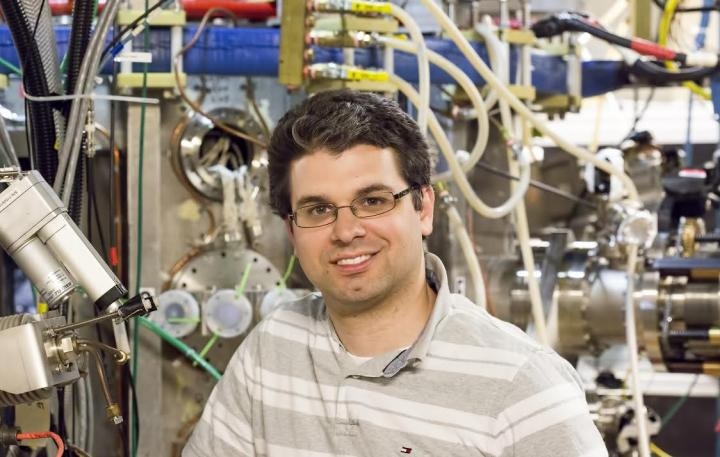Jul 6 2017
Two major issues confronting magnetic-confinement fusion energy are enabling the walls of devices that house fusion reactions to survive bombardment by energetic particles, and improving confinement of the plasma required for the reactions. At the U.S. Department of Energy's (DOE) Princeton Plasma Physics Laboratory (PPPL), researchers have found that coating tokamak walls with lithium-- a light, silvery metal-- can lead to progress on both fronts.
 Physicist Dennis Boyle is pictured. (Credit: Elle Starkman/PPPL Office of Communications)
Physicist Dennis Boyle is pictured. (Credit: Elle Starkman/PPPL Office of Communications)
Recent experiments on the Lithium Tokamak Experiment (LTX), the first facility to fully surround plasma with liquid lithium, showed that lithium coatings can produce temperatures that stay constant all the way from the hot central core of the plasma to the normally cool outer edge. The findings confirmed predictions that high edge temperatures and constant or nearly constant temperature profiles would result from the ability of lithium to keep stray plasma particles from kicking -- or recycling -- cold gas from the walls of a tokamak back into the edge of the plasma.
Near 100 million degrees Celsius
Fusion devices will operate near 100 million degrees Celsius, hotter than the 15 million-degree core of the sun. The edge of the plasma, just a few meters from the 100 million-degree core, will normally be a relatively cool few thousand degrees, like the ionized gas -- or plasma -- inside a fluorescent light bulb. "This is the first time that anybody has shown experimentally that the edge of the plasma can remain hot due to reduced recycling," said physicist Dennis Boyle, lead author of a paper published online July 5 in the journal Physical Review Letters. Support for this work comes from the DOE Office of Science.
A hotter edge can improve plasma performance in numerous ways. Preventing recycled gas from cooling the edge reduces the amount of external heating that must be applied to keep the plasma hot enough for fusion to occur, making a reactor more efficient. "If the edge is hot, it expands the volume of plasma available for fusion," Boyle said, "and the lack of a temperature gradient prevents instabilities that reduce plasma confinement."
Researchers performed this set of experiments with solid lithium, Boyle explained, but a coating of liquid lithium could produce similar results. Physicists have long used both forms of lithium to coat the walls of LTX. Since flowing liquid lithium could absorb hot particles but wouldn't wear down or crack when struck by them, it also would reduce damage to tokamak walls - another critical challenge for fusion.
Upgrade next
Physicists performed the recent research prior to an upgrade of the LTX, which currently is in progress. The upgrade will add a neutral beam injector that will fuel the core of the plasma and supply more heating and plasma density to test whether lithium can still keep the temperature constant in conditions closer to an actual fusion reactor.
Achieving constant temperature profiles has been a major goal of LTX. Reaching that goal "gives evidence for a new, potentially high-performance plasma regime for fusion devices,"wrote the authors. The next step will be to see whether such a regime can be attained.